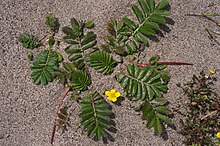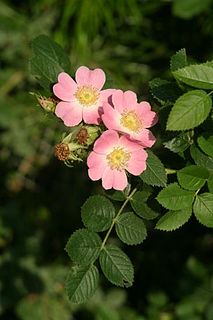
The rose subfamily Rosoideae consists of more than 850 species, including many shrubs, perennial herbs, and fruit plants such as strawberries and brambles. Only a few are annual herbs.

Potentilla is a genus containing over 300 species of annual, biennial and perennial herbaceous flowering plants in the rose family, Rosaceae. They are usually called cinquefoils in English, but they have also been called five fingers and silverweeds. Potentilla are generally only found throughout the northern continents of the world (holarctic), though some may even be found in montane biomes of the New Guinea Highlands. Several other cinquefoils formerly included here are now separated in distinct genera - notably the popular garden shrub P. fruticosa, now Dasiphora fruticosa.
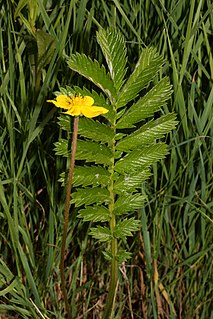
Argentina anserina is a perennial flowering plant in the rose family, Rosaceae. It is known by the common names silverweed, common silverweed or silver cinquefoil. It is native throughout the temperate Northern Hemisphere, often on river shores and in grassy habitats such as meadows and road-sides. The plant was originally placed in the genus Potentilla by Carl Linnaeus in his Species plantarum, edition 1, (1753) but was reclassified into the resurrected genus Argentina by research conducted in the 1990s. The reclassification remains controversial and is not accepted by some authorities. It is a species aggregate which has frequently been divided into multiple species.

Dasiphora fruticosa is a species of hardy deciduous flowering shrub in the family Rosaceae, native to the cool temperate and subarctic regions of the northern hemisphere, often growing at high altitudes in mountains. Dasiphora fruticosa is a disputed name, and the plant is still widely referenced in the horticultural literature under its synonym Potentilla fruticosa. Common names include shrubby cinquefoil, golden hardhack, bush cinquefoil, shrubby five-finger, and widdy.
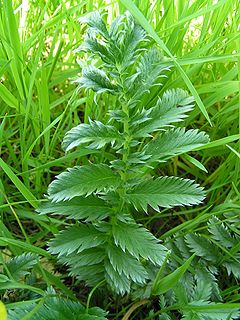
Argentina (silverweeds) is a genus of plants in the rose family (Rosaceae) which is accepted by some authors, as containing 64 species, but classified in Potentilla sect. Leptostylae by others.

Potentilla reptans, known as the creeping cinquefoil, European cinquefoil or creeping tormentil, is a flowering plant in the family Rosaceae.
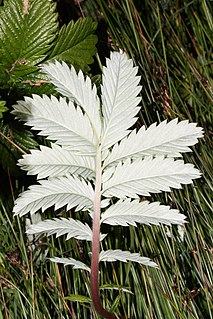
Argentina pacifica, sometimes called pacific silverweed, silverweed cinquefoil, or simply silverweed, is a low-growing perennial (6") with pinnately compound green leaves with silvery undersides. It is a member of the species aggregate known as Argentina anserina or Potentilla anserina. The yellow, saucer-shaped flowers appear late spring through summer. Pacific silverweed spreads very quickly in moist areas. Preferring salt marshes, river estuaries and shorelines, they are often seen growing alongside springbank clover. They need sun and regular water.
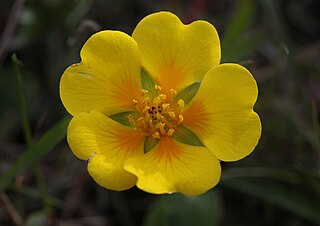
Potentilla hickmanii is an endangered perennial herb of the rose family. This rare plant species is found in a narrowly restricted range in two locations in coastal northern California, in Monterey County, and in very small colonies in San Mateo County. This small wildflower, endemic to western slopes of the outer coastal range along the Pacific Ocean coast, produces bright yellow blossoms through spring and summer.
British NVC community MG11 is one of the mesotrophic grassland communities in the British National Vegetation Classification system. It is one of three types of mesotrophic grassland classified as grass-dominated inundation communities.

Portencross is a hamlet near Farland Head in North Ayrshire, Scotland. Situated about 3 km (2 mi) west of Seamill and about 2 km (1.2 mi) south of Hunterston B nuclear power station, it is noted for Portencross Castle.
NVC community SD17 is one of the 16 sand-dune communities in the British National Vegetation Classification system.

Potentilla recta, the sulphur cinquefoil or rough-fruited cinquefoil, is a species of cinquefoil. It is native to Eurasia but it is present in North America as an introduced species, ranging through almost the entire continent except the northernmost part of Canada and Alaska.

Stigmella splendidissimella is a moth of the family Nepticulidae. It is found from Scandinavia to Italy and from Ireland to the Crimea. It is not found in the Iberian Peninsula and the Balkan Peninsula.

Stigmella poterii is a moth of the family Nepticulidae. It is found from Fennoscandia to the Pyrenees and Italy, and from Ireland to Ukraine.

Philedonides lunana, also known as the heath tortrix and Walker’s Lanark tortrix, is a moth of the family Tortricidae. It was first described by Carl Peter Thunberg in 1784 and is found in most of Europe.
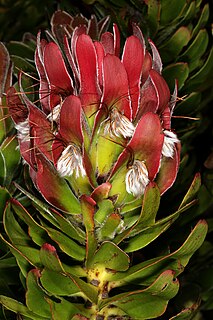
Mimetes fimbriifolius, also called cowl pagoda or the fringed pagoda, is a species of plant in the family Proteaceae. It is a dense, rounded, multi-branched tree that grows up to 4 metres in height. This attractive and striking plant flowers all year round, and produces red and yellow branch-heads and inflorescences. The nectar-rich flowers are pollinated by sunbirds and the seeds are distributed and taken underground by ants before germinating. It is endemic to the Table Mountain range in the city of Cape Town, South Africa.
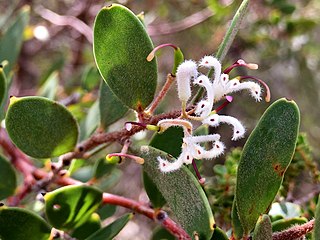
Hakea lasiantha, commonly known as the woolly-flowered hakea, is a shrub in the family Proteacea endemic to an area along the south coast in the South West and Great Southern regions of Western Australia.

Byturus ochraceus is a species of beetle in the fruitworm family Byturidae.

Potentilleae is a tribe of the rose family, Rosaceae.
